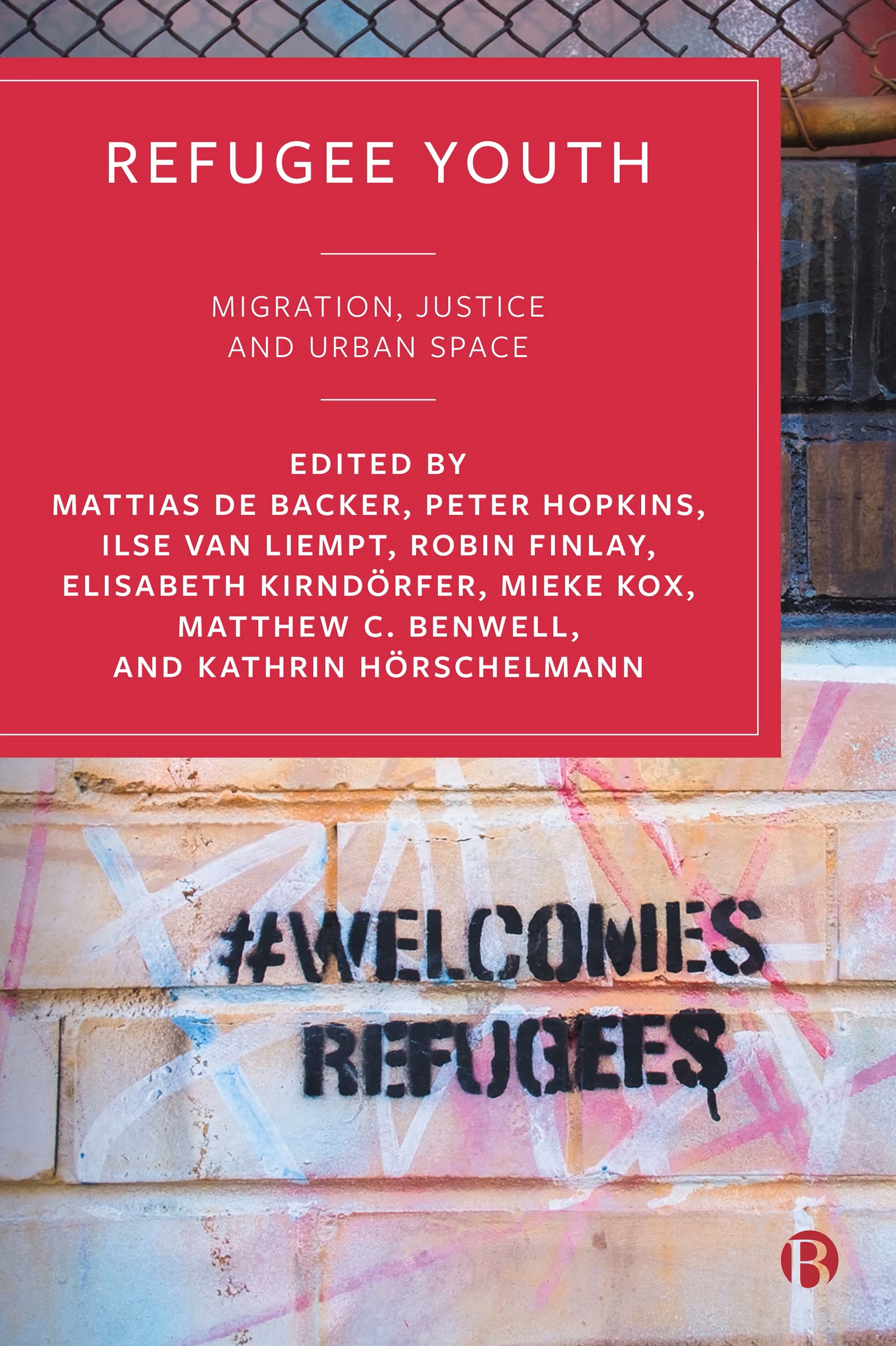Interview with Peter Hopkins, Matthew Benwell, and their co-editors about their new collection, Refugee Youth: Migration, Justice and Urban Space
Our members, Peter Hopkins and Matthew Benwell (Newcastle University, UK), and their co-editors, Mattias De Backer (KU Leuven, Belgium), Ilse van Liempt (Utrecht University, Netherlands), Robin Finlay (Newcastle University, UK), Elisabeth Kirndörfer (University of Bonn, Germany), Mieke Kox (Erasmus University Rotterdam, Netherlands), and Kathrin Hörschelmann (University of Bonn, Germany), talk about their new collection, Refugee Youth: Migration, Justice and Urban Space (Bristol University Press, 2023).

Q: What is this edited collection about?
Refugee Youth: Migration, Justice and Urban Space tells the stories of young refugees in a range of international urban settings and explores how newcomers navigate urban spaces and negotiate multiple injustices in their everyday lives. This innovative edited volume is based on in-depth, qualitative research with young refugees and their perspectives on migration, social relations, and cultural spaces. The chapters give voice to refugee youth from a wide variety of social backgrounds, including insights about their migration experiences, their negotiations of spatial justice and injustice, and the diverse ways in which they use urban space.
Chapters focus on a diversity of topics including a community theatre project in Leipzig, racialised dispossession in Denmark, Venezuelan youth in Brazilian schools, and everyday experiences of urban space in Amsterdam. Moreover, attention is given to young Rohingya in Malaysia, refugee youth and urban planning in Amman, senses of belonging amongst Tibetan refugees in India, and the experiences of Syrian students in Istanbul. In addition, you can learn about Australian Sudanese and South Sudanese youth, about migrant women in a South African township, young migrant men in Cork, and the making of home through music in Kinshasa and Dar es Salaam. The chapters are contextualised in a short introduction and conclusion as well as short reflective chapter by Les Back about planetary listening.
Q: What made you initiate this volume?
We initiated this collection as a group of editors as we have been collaborating for several years now on a project about refugee youth and public space. This project was funded by the Humanities in the European Research Area (HERA) Public Spaces call through which we secured funding to explore the lived experiences of young refugees in the cities of Leipzig, Amsterdam, Brussels, and Newcastle upon Tyne.
As part of this project, we have produced animated videos about refugee arrivals, refugee experiences and negotiations of public space, as well as their experiences of the covid-19 pandemic. Our project website provides further details about the work we have been doing, including a link to our final report which is available in English, German, French, and Dutch. A couple of the chapters in the edited collection are based on fieldwork we conducted as part of this project.
An excerpt from the introductory chapter:
This book explicitly focuses on refugee youth’s negotiations of spatial, social and economic justices and injustices in the public urban spaces in which they arrive after migration. It takes refugee youth as active agents and gives priority to their voices and experiences; the importance of listening to such accounts is emphasised by Les Back in Chapter 14. By putting personal and everyday geographies of refugee youth central, we do not overlook structural forms of exclusion that take place, but we show how young people themselves make sense of their lives in the new places of arrival. By putting their experiences centre stage, we extend scholarship on refugee youth beyond its dominant focus on social work practices and welfare services (eg Kohli, 2006; Nelson et al, 2016), policy-related responses (eg Bhabha & Schmidt, 2008; Menjivar & Perreira, 2017; Parusel, 2017), and psychosocial wellbeing (eg Bean et al, 2007; Derluyn & Broekaert, 2008; Stotz et al, 2015).
Thus, some chapters take young refugees’ everyday experiences as a starting point to reflect on the infrastructural and organisational context and broader issues of spatial justice. Other chapters, however, work the other way around, by first exploring the legal-political context of migration management, in which, later on, actors within the arrival infrastructure and young refugees’ everyday experiences are located.
Our focus on public space takes existing scholarship on refugee youth even further because it offers opportunities to explore meaningful spaces for refugee youth in the city that go beyond formal community or organisational settings and include spaces that might be created by refugee youth themselves. It also allows us to explore the notion of visibility along the lines of recognition. In this sense, recognition refers to ‘acts of resistance and empowerment by minority groups against the mainstream, for instance, how they claim a space to make themselves visible’ (De Backer, 2019, p 309) in the urban landscape.
As younger people, refugee youth are worthy of study in their own right (Hopkins, 2020; Hopkins & Hill, 2008, 2010). Not only are refugee youth a significant cohort of the overall refugee population, but they are also especially worth paying attention to, given the important role they can play in the future of the society and in politics and the economy. Younger people also offer an important vantage point from which to view broader aspects of social continuity and social change; indeed, it is often among young people that we first start to see the emergence of social changes and transformation, so they have the potential to offer valuable insights into the future. In this book, numerous examples are given of how refugee youth – despite strong and strict politics of belonging – claim space and recognition in the cities where they have settled and how new places and encounters are shaping up as a result of these interventions by young people.